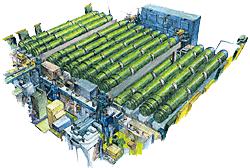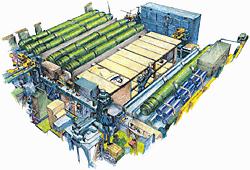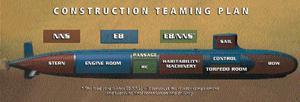The New Attack
Submarine – whose
lead ship will be the USS Virginia (SSN-774) – charts an exciting new course for the
U.S. Navy. The breadth of missions and corresponding concepts of operation envisioned for
this new submarine reflect significant changes in U.S. thinking on the nature of undersea
warfare. The bulk of the present attack submarine force consists of Los Angeles
(SSN-688)-class ships in several variants. The Navy created this class primarily for
direct support of carrier battle groups and deep-water anti-submarine warfare against the
massive undersea forces fielded by the Soviet Union during the Cold War. Acoustic stealth
and high speed were key factors in the 688-class design. At the height of the Cold War,
the Soviets began to field SSNs nearly as stealthy acoustically as the 688 class. The U.S.
Navy responded in turn with the Seawolf (SSN-21) class. Originally planned for 29 ships,
Seawolf emerged as the ultimate open-ocean ASW platform: faster, quieter, more heavily
armed, and equipped with better acoustic sensors than any attack submarine in the world.
Fundamentally, however, Seawolf’s underlying concept was little different from that
of the 688s.
The New Attack
Submarine: Optimized for the Littorals
In contrast, Virginia breaks new ground. Since
the end of the Cold War, the Navy has shifted its focus from preparing for open-ocean
conflict to dominating the littorals from the sea to influence events ashore. In response
to this fundamental shift, Virginia has been designed specifically to fight in the
world’s littorals. While maintaining a robust capability for open-ocean ASW, Virginia
nonetheless incorporates weapons, sensors, and some special new equipment and features
that suit her particularly well for joint operations in shallower coastal regions,
including land attack, intelligence gathering, mine reconnaissance and supporting special
forces. Additionally, Virginia will be the acoustic equal of Seawolf while adding new
non-acoustic stealth features for the survivability it needs to operate in future tactical
environments, which will likely include greater threats from mines and non-traditional ASW
methods.

Equipped with a unique
nine-man lock-in / lock-out chamber.
Although Virginia’s
maximum speed and total weapons capacity are less than Seawolf’s, it will have a
wider and more flexible range of military capabilities. The ship will deploy covert,
non-provocative electronic and acoustic sensors for continuous monitoring of the regional
battlespace, including enemy electronic signals, communication links, and the local
tactical situation. Its acoustic sensor suite will include a much-improved high frequency
sonar specifically optimized for hunting diesel-electric and advanced air-independent
propulsion (AIP) submarines, mines, and shallow-water hazards to navigation. Virginia will
support a full range of covert special warfare missions – search and rescue,
reconnaissance, sabotage and diversionary attacks, forward observation for fire direction,
and direct strikes against enemy objectives. The torpedo room is re-configurable –
allowing both the center weapons and their stowage structures to be removed – to
accommodate greater numbers of Special Forces “troops.” Equipped with a unique
nine-man lock-in/lock-out chamber, Virginia can conduct covert launch and recovery of an
entire Special Forces team in a single evolution. There are also mating surfaces
compatible with either the Advanced Seal Delivery System (ASDS) – essentially a
55-ton mini-submarine – or the more conventional Dry Deck Shelter.
The weapon load-out is
impressive. Virginia will carry 38 full-size weapons, allocated among heavyweight
torpedoes, Tomahawk Land-Attack Missiles (TLAMs), and mines. Equipped with twelve Vertical
Launching System (VLS) tubes and four 21-inch torpedo tubes, Virginia can launch
land-attack salvos of up to 16 missiles. This flexible firepower gives Virginia a powerful
capability to engage not only hostile ships and submarines, but also to attack high-value
land targets, with both precision and surprise, from well within an adversary’s air
defense umbrella.
The VLS and torpedo tubes add
their own flexibility. The VLS will permit future installation of a navalized version of
the 160-mile range Army Tactical Missile System (ATACMS) or similar weapons, when they are
eventually acquired. The torpedo tubes will support launch and recovery of Unmanned
Underwater Vehicles (UUVs), such as the Long-Term Mine Reconnaissance System (LMRS),
currently scheduled to enter service in 2003 (one year prior to Virginia) or the
deployment of Unmanned Aerial Vehicles (UAVs), if tube-launched versions are developed.
Preparation of the
Battlespace – Acoustic Sensors and Processing
The Virginia will carry a mix of both
“tried and true” and innovative acoustic sensors. The heart of the sonar suite
will comprise a Spherical Active/Passive Array, the Lightweight Wide Aperture Array, and
the TB-29(A) Thin-Line Towed Array. The new Lightweight Wide Aperture Array is optimized
for locating quiet diesel-electric submarines. Additionally, the high-frequency sonar
suite will consist of a sail-mounted array and a new “chin”-mounted array,
located right beneath the sphere. With the addition of the chin-array and improved
processing and displays, Virginia provides the Submarine Force with its best-ever
hull-mounted mine detection and avoidance capability. On the processing side, the Virginia
sonar system will use a variant of the Acoustic Rapid COTS Insertion (AN/BQQ-10) system
that is being backfit on the 688- and TRIDENT-class boats (Ed. Note: see pp. 26-27 of the
Fall Issue of UNDERSEA WARFARE). Additionally, Virginia gets an innovative acoustic
intercept system (WLY-1) that will incorporate six additional sensors and introduce a
capability to estimate target range as well as bearing. In conjunction with UUVs and other
off-board sensors, such as the Advanced Deployable System, the Virginia’s sonar suite
provides a powerful capability for Joint Task Force and Carrier Battle Group Commanders to
prepare and monitor the undersea battlespace before committing follow-on forces.
A Submarine Without a
Periscope!
The most radical change in the Virginia sensor suite appears in the ship’s control
room. The electromagnetic and electro-optics suite will include two non-hull-penetrating
Photonics Masts, without a conventional periscope. This is a major break with tradition
for the Submarine Force. The Officer of the Deck will no longer stand and
“hang-on” the periscope, looking through a maze of mirrors, prisms, and lenses.
Instead, the Photonics Mast contains several high-resolution, color cameras that send
visual images to large screen displays in the ship’s control room. Equipped with
enhanced infrared and low-level light image enhancement features, the mast also includes
an infrared laser range finder, making the art of calling periscope ranges much less
challenging! Furthermore, the mast will embody an improved integrated Electronic Support
Measures (ESM) array and associated signal processing for unparalleled situational
awareness – all gained covertly from under the sea.

Multi-function large screen
displays and a wide open layout
will enable improved information flow and better decision making.
Harnessing the Revolution in
Information Technology – The Combat Network
To support an unprecedented array of joint littoral warfare missions, Virginia will deploy
with capabilities for Command, Control, Communications, Computers, Intelligence,
Surveillance, and Reconnaissance (C4ISR) unknown in earlier attack submarines. Like our
688s and Seawolfs with modernized capabilities, the Virginia class will be a key
“node” within the emerging concept of Network-Centric Warfare and will be
equipped with state-of-the-art combat systems fully linked to external targeting and
intelligence grids. Virginia will maximize commonality with the Surface Navy and other
joint forces by fielding the latest capabilities for building Common Tactical and
Operating Pictures and supporting the coordination and launch of TLAMs. Off-board sensor
information will be fused directly with own-ship data to yield a comprehensive and
accurate view of the tactical situation shared mutually among U.S. and coalition forces.
Within the hull, a wideband Local Area Network built to commercial industry standards will
completely link all of Virginia’s combat control and communications systems. Modular,
open system architecture and the use of standardized shock-isolated equipment enclosures
to accommodate both COTS and government-furnished hardware are key enablers of this
approach. Consequently, the cost of custom “MilSpec” developments can be
avoided, and the open system approach will allow more advanced microcomputers, signal
processors, and software algorithms to be incorporated as requirements change or more
capability becomes available in the commercial marketplace.


The torpedo room is
re-configurable - allowing both the center weapons and their
stowage structures to be removed - to accomodate greater numbers of Special Forces troops.
Reduced Watchstation Manning
Virginia’s new capabilities have not required any additional crew. In fact, a
thorough re-engineering of the ship’s functionality, manpower requirements, and
billet structure has enabled the reduction of 15 crew watchstanders in comparison to
Seawolf. The key to this greater efficiency has been technology insertion, particularly
for automating tasks and handling information, and Virginia’s modular design will
facilitate even further reductions as new technologies become available. Typical
efficiencies are found in the following areas:
- Ship Control Station:
Virginia’s digital “fly-by-wire” advanced ship control station will be
operated by a Pilot, Copilot, and a Relief Pilot. These three watchstanders replace the
customary Diving Officer, Chief of the Watch, Helmsman, Planesman, and Messenger needed on
previous submarine classes.
- Navigation - Quartermaster Watch-
station: The increased use of automation, such as electronic charting, allows
combining the duties of the Navigation Electronics Technician and the Quartermaster of the
Watch into those of a single Navigation Watchstander.
- Throttleman – Reactor Operator
Watchstation: Increased use of technology and automation allows the Reactor
Operator also to perform the duties of the Throttleman while carrying out his current
responsibilities.
- Auxiliaryman Aft Watchstation:
The relative simplicity and innovative automation of Virginia’s engineroom will allow
engineroom personnel to monitor installed auxiliary equipment, thus eliminating the
Auxiliaryman Aft watchstation.
- Torpedo Room Watch:
Automated systems and tours by other watchstanders allow the elimination of the Torpedo
Room watchstander.
A New Building Approach:
Construction Teaming
The design and construction techniques adopted for Virginia are innovative in their own
right. Of these, modularity is perhaps the most important. The teaming arrangement between
General Dynamics’ Electric Boat Corporation and Newport News Shipbuilding for
building this new class allocates major sections of the ship to one yard or the other, so
modularity by hull section is inherent from the outset. In addition, large, internal
sub-assemblies are fabricated and tested separately before they are “packed”
into the hull as Modular Isolated Deck Sections (MIDS). The design process itself
incorporates both concurrent engineering design/build teams and an extensive
infrastructure for computer-aided design, engineering, and manufacturing (CAD/CAE/CAM).
Each design/build team is responsible for a specific aspect of the ship’s structure
or mission capability and includes Navy managers, fleet operators, technical personnel,
key vendors and suppliers, and the shipyard’s designers and waterfront construction
supervisors.

Virginia is the first American warship
designed solely by computer. The design itself is embodied in three-dimensional electronic
drawings of individual components, systems, and major deck assemblies, totally replacing
the paper drawings and wooden mock-ups of the past. These electronic representations can
also be manipulated to simulate virtual reality “walk-throughs” and “what
if?” engineering options, for validating design and engineering decisions before any
metal is bent. Further, when actual construction begins, the computer-based design
elements will be linked directly to the machinery that cuts steel, bends pipe, machines
components, and maintains an integrated inventory control system.
The Virginia class incorporates many recent
advances in submarine-related hydrodynamics, underwater explosion survivability,
propulsion machinery, metallurgy, and reduction of non-acoustic signatures. These include:
- A propulsion plant with fewer pumps and
valves that produces less noise
- The use of tougher structural steel for a
thinner hull than that of the Los Angeles class
- A more advanced electromagnetic silencing
system to reduce the ship’s magnetic signature, for reduced vulnerability to magnetic
mines in littoral regions
- A platform-wide fiber optic cable system for
easy “plug-in/plug-out” equipment integration, with provision for future growth
- An ultra-quiet, high-power-density main
propulsion unit and weapons launch and handling system components, which will be smaller,
fewer, and less expensive than those on Seawolf, while equally capable
- A “life of the ship” reactor core.
The ship’s reactor plant design has been simplified and requires fewer components. It
sustains Seawolf-level quieting in a 25 percent smaller volume. New concept steam
generators and a solid-state electric power distribution system will both improve
performance and cut costs.
The Virginia Class –
Building for Tomorrow’s Attack Submarine Force
Advance procurement for the lead ship was funded in FY 1996, and construction began in
1998. The first-of-class Virginia will enter the Fleet in 2004, and a total of four NSSNs
have been approved through FY 2002. Series production of an average of two NSSNs per year
beginning in FY 2005 is the only way to preserve the minimum-essential 50-SSN force level
confirmed by the Quadrennial Defense Review – as well as this unique aspect of the
U.S. defense industrial base. Since reducing acquisition and life-cycle costs has been a
major objective in the design and engineering process, the ship is affordable in
sufficient numbers to satisfy America’s future force level requirements.
The Virginia class is thus well underway to
becoming the core of the attack submarine force of the future – a force as much at
home in the littorals of the world as her predecessors were in the deep oceans – and
one which will ensure continued U.S. undersea warfare superiority.
Barbara Graves is a naval analyst and
editor at the Center for Security Strategies and Operations, Techmatics/Anteon
Corporation, Arlington, VA, and Dr. Edward Whitman is a Technical Director in the same
organization.
|
